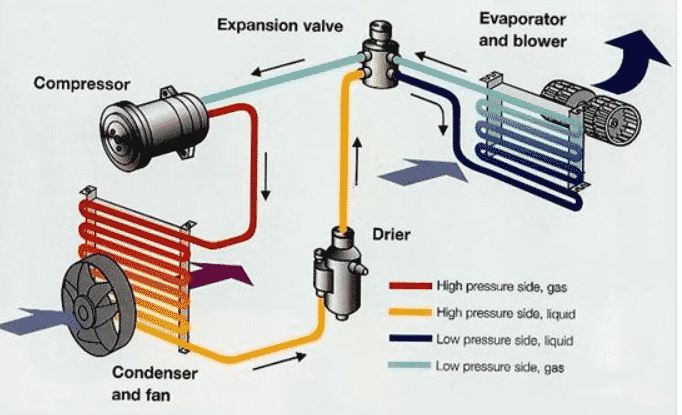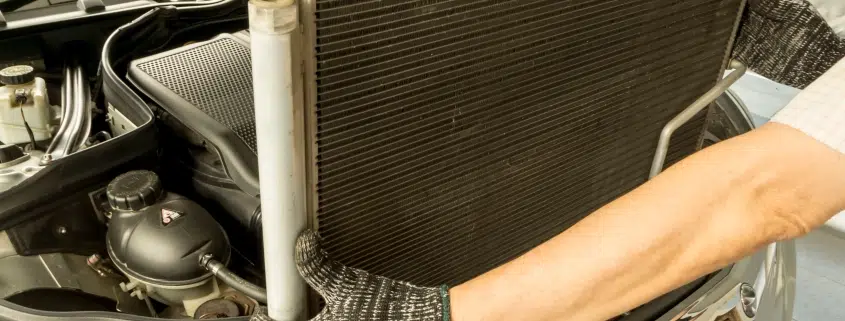Everything that can go wrong with your Car Aircon condenser
Were you expecting crisp cold air from your air conditioning, only to find it’s blowing ambient temperature or even hot air? That’s a pretty good indicator there’s a problem with your car’s air conditioning system. This is also a common symptom of condenser failure.
There are several components to your car’s air conditioning, but today our job is to help you catch the culprit (in this case the condenser) and better understand the system.
Natrad offers a nationwide warranty on all car air conditioning condensers fitted to your car. If you’re in need of a replacement, Nip into Natrad today for specialist advice.
Why is my car air conditioner not working?
There are several reasons why your automotive air conditioner (AC) might not be working effectively. One common issue could be faulty components, such as a malfunctioning AC condenser. If the condenser fails, it won’t be able to produce cold air, leaving your vehicle’s air conditioning system ineffective. You may find that the condenser needs to be replaced, which can lead to significant replacement costs if you don’t address it promptly. In fact, ignoring condenser problems can damage the condenser further.
Everything that can go wrong with your AC condenser
Your car’s AC system is made up of several interconnected components, and understanding how they work can be tricky. Key parts include the condenser, compressor, evaporator, receiver drier, and TX valve or orifice tube. Among these, the condenser plays a vital role in cooling the refrigerant, and when it fails, it can lead to bigger and more expensive problems.
To make it easier for you, we’ve created a simple guide to help you identify the signs of a failing condenser. With the right knowledge, you can catch problems early and avoid unnecessary repairs.
Aircon system
Your car’s air conditioning system revolves around one crucial process: the circulation of refrigerant. This remarkable substance transforms between liquid and gas states depending on pressure and temperature. This continuous cycle is what enables your AC to deliver cool, refreshing air during those scorching summer drives.
As the refrigerant travels through the system, it transitions between liquid and gas multiple times. Each stage of the cycle plays a specific role in cooling your car. To simplify this complex process, we’ve created a diagram to illustrate the flow and explain each step.

(Image courtesy of Go Motorwise, Blidworth UK)
At the heart of this cycle is the condenser, which receives hot, high-pressure refrigerant gas from the compressor. The gas flows through the condenser’s network of tubes, much like coolant passes through a radiator, preparing for the next stage of cooling.
As air flows over the condenser fins, it absorbs heat from the refrigerant, cooling it down and causing it to condense into a liquid. This liquid refrigerant then moves to the receiver drier, where excess moisture is removed. From there, it continues its journey through the AC system, ensuring your car stays cool and comfortable.
Condenser failure
Now that you understand the role the condenser plays, you might want to know why it can go wrong. It’s particularly important to pinpoint the clear cause of failure or inadequate cooling to avoid further damage within the system. A malfunctioning component could contaminate the system and cause other parts to ‘bite the dust’ as well.
So what are some common causes of condenser failure?
- Damage or blockage
- Weld failure
- Holes in tubes
- Collision damage
- Leakage
Understanding the main causes of aircon condenser failures
Let’s take a closer look into some of the issues that may cause a car condenser to fail.
External debris causing damage or blockage
One of the most common causes of condenser failure is damage or blockage from external debris. Since the condenser is located at the front of the car, it’s exposed to dirt, grime, leaves, insects, and even small pebbles or stones. These can clog or block the fins, reducing airflow and the system’s ability to cool effectively. Bent fins from impacts can also lower heat transfer efficiency, making the condenser less effective. Regular cleaning and inspection can help prevent these issues.
Weld failure or cracks leading to leakage
Weld failure or cracks in the condenser are significant problems, as they often result in refrigerant leakage. Without sufficient refrigerant, the heat transfer cycle breaks down, leaving your AC unable to cool properly. A cracked condenser, especially one with damaged tubes, usually requires a full replacement to restore functionality. If you notice refrigerant leaks, it’s crucial to address the issue quickly to avoid further damage to your system.
Front-end collisions and condenser damage
If your car has been involved in a front-end collision, there’s a high chance the condenser may have been damaged. This can lead to performance issues or refrigerant loss. At Natrad, we can assess the damage and determine whether the condenser can be repaired or if replacement is the safer option. Running your AC system with a damaged condenser can harm other components, so it’s essential to address the problem promptly.
Seal breakage and refrigerant leaks
Leaks in the condenser can also occur due to seal failure, often found on the high-pressure side of the AC system. Refrigerant contains a special oil that lubricates seals and moving parts. When the AC system isn’t used for long periods, these seals can dry out and fail. Corrosion or deterioration of the tubes may also lead to leaks. Regardless of the cause, fixing these leaks is vital to ensure your AC system runs smoothly and efficiently. Regular system checks can help catch seal issues before they escalate.
How to tell if your AC condenser is going bad
We’ve covered a lot of the causes, but how can you tell if any of this is happening? Watch out for the following clues;
- Visible damage or blockages to the condenser fins
- Reduced cooling, such as warm air or weak airflow
- Warning lights. Some cars have the ability to let you know if something has gone wrong in the system.
- Engine overheating. Since the condenser is usually mounted in front of the radiator, a blocked condenser can restrict air flow to the radiator.
- Failed A/C compressor. When the compressor fails, internal wear can create metal dust which circulates through the entire A/C system, contaminating the condenser and blocking the tubes.
If you’ve noticed any of these signs, then it’s time to act. Air conditioner repairs must be done by a licensed refrigerant technician using the correct tools, so it’s best not to attempt any fixes yourself. Natrad technicians are highly trained in cooling and air conditioning systems and can advise you on the best next step.
Get your car AC condenser repaired at Natrad
With our nationwide network of workshops, high-quality parts, and advanced tools, we can repair or replace your condenser efficiently and reliably. Plus, we back our work with industry-leading warranties for your peace of mind.
Don’t let a damaged condenser disrupt your comfort—visit your nearest Natrad store today for efficient AC repairs. Our friendly team is ready to help restore your car’s air conditioning system and get you back on the road with confidence. Contact us now to book your service









